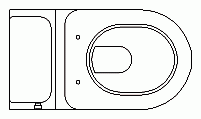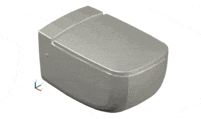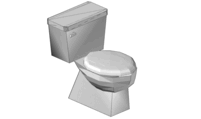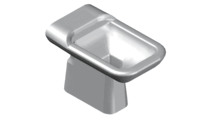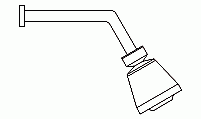CAD Blocks categories
 3D models
3D models home furniture
home furniture sanitary ware - bathrooms
sanitary ware - bathrooms professional equipment
professional equipment doors and windows
doors and windows people and animals
people and animals plants and trees
plants and trees vehicles - transports
vehicles - transports architectural details
architectural details mechanical - electrical
mechanical - electrical urban planning - civil works
urban planning - civil works safety health construction
safety health construction accessible design
accessible design drawing sheet
drawing sheet signals
signals construction machinery
construction machinery accessories and objects
accessories and objects maps and street maps
maps and street maps
High-Quality Toilet Flush Tank CAD Drawings

size: 6 kb
category: sanitaryware - water closet
description: Side View of a Toilet with Flush Tank: traditional two-piece toilet
file extension: .dwg CAD - AutoCAD software
High-Quality Toilet Flush Tank CAD Drawings
Introduction to Toilet Flush Tank CAD Blocks
The toilet flush tank is an essential component in modern plumbing systems, providing the necessary water pressure to effectively flush waste from toilets. These CAD blocks offer detailed representations of flush tanks, which are crucial for architects and engineers designing efficient and effective bathroom layouts. Understanding the mechanics and placement of a toilet flush tank is vital for ensuring the overall functionality of any bathroom design.
Dimensions and Specifications
Toilet flush tanks typically come in a range of sizes, with the most common being around 14 inches by 9 inches by 6 inches (35.56 cm x 22.86 cm x 15.24 cm). These dimensions provide adequate water storage for a standard flush, which typically uses between 1.6 to 3.5 gallons (6.05 to 13.25 liters) of water per flush. The size and capacity of the flush tank are important considerations in bathroom design to ensure compatibility with various toilet models and to meet specific water usage requirements.
Types and Variants
There are several types of toilet flush tanks available, including gravity flush tanks, pressure-assisted tanks, and dual-flush tanks. Gravity flush tanks are the most common, using the weight of the water to create flushing pressure. Pressure-assisted tanks provide a more powerful flush by using air pressure to boost water flow, making them ideal for commercial settings. Dual-flush tanks offer a more environmentally friendly option, with separate flush mechanisms for liquid and solid waste, allowing for water conservation.
Usage Tips for Optimal Performance
When selecting and installing a toilet flush tank, it’s essential to consider the water pressure in your area and the specific needs of the toilet model you are using. Ensure the flush tank is correctly aligned with the toilet bowl to prevent leaks and optimize flushing efficiency. Additionally, regular maintenance of the flush tank, such as checking for leaks and ensuring the internal components are functioning correctly, will prolong the life of the system and prevent costly repairs.
Frequently Asked Questions about Toilet Flush Tanks
1. What causes a toilet flush tank to keep running? This common issue is often due to a faulty flapper, which may not seal properly, causing water to leak from the tank into the toilet bowl. Replacing the flapper usually resolves this problem.
2. How much water does a toilet flush tank hold? Standard toilet flush tanks typically hold between 1.6 to 3.5 gallons (6.05 to 13.25 liters) of water, depending on the type of flush system used. Dual-flush tanks may have different capacities for full and half flushes.
3. How can I improve the efficiency of my toilet flush tank? You can improve efficiency by ensuring the tank's internal components are functioning correctly and by considering a dual-flush system, which allows for water conservation by using less water for liquid waste flushes.
4. What is the best material for a toilet flush tank? The most common materials are ceramic and plastic. Ceramic tanks are durable and easy to clean, while plastic tanks are lighter and may be easier to install but are less durable over time.







